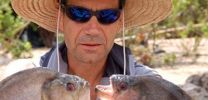(Press-News.org) A new study co-authored by the Georgia Institute of Technology indicates that clay minerals, rocks that usually form when water is present for long periods of time, cover a larger portion of Mars than previously thought. In fact, Assistant Professor James Wray and the research team say clays were in some of the rocks studied by Opportunity when it landed at Eagle crater in 2004. The rover only detected acidic sulfates and has since driven about 22 miles to Endeavour Crater, an area of the planet Wray pinpointed for clays in 2009.
The study is published online in the current edition of Geophysical Research Letters.
The project, which was led by Eldar Noe Dobrea of the Planetary Science Institute, identified the clay minerals using a spectroscopic analysis from the Mars Reconnaissance Orbiter. The research shows that clays also exist in the Meridiani plains that Opportunity rolled over as it trekked toward its current position.
"It's not a surprise that Opportunity didn't find clays while exploring," said Wray, a faculty member in the School of Earth and Atmospheric Sciences. "We didn't know they existed on Mars until after the rover arrived. Opportunity doesn't have the same tools that have proven so effective for detecting clays from orbit."
The clay signatures near Eagle crater are very weak, especially compared to those along the rim and inside Endeavour crater. Wray believes clays could have been more plentiful in the past, but Mars' volcanic, acidic history has probably eliminated some of them.
"It was also surprising to find clays in geologically younger terrain than the sulfates," said Dobrea. Current theories of Martian geological history suggest that clays, a product of aqueous alteration, actually formed early on when the planet's waters were more alkaline. As the water acidified due to volcanism, the dominant alteration mineralogy became sulfates. "This forces us to rethink our current hypotheses of the history of water on Mars," he added.
Even though Opportunity has reached an area believed to contain rich clay deposits, the odds are still stacked against it. Opportunity was supposed to survive for only three months. It's still going strong nine years later, but the rover's two mineralogical instruments don't work anymore. Instead, Opportunity must take pictures of rocks with its panoramic camera and analyze targets with a spectrometer to try and determine the composition of rock layers.
"So far, we've only been able to identify areas of clay deposits from orbit," said Wray. "If Opportunity can find a sample and give us a closer look, we should be able to determine how the rock was formed, such as in a deep lake, shallow pond or volcanic system."
As for the other rover on the other side of Mars, Curiosity's instruments are better equipped to search for signs of past or current conditions for habitable life, thanks in part to Opportunity. Wray is a member of Curiosity's science team.
### END
Clays on Mars: More plentiful than expected
2012-12-21
ELSE PRESS RELEASES FROM THIS DATE:
Lifestyle changes linked to better outcomes after peripheral intervention
2012-12-21
ANN ARBOR, Mich. – Patients who quit smoking and took an aspirin and statin before undergoing treatment for blocked leg arteries were less likely to suffer a complication six months later, according to new research led by the University of Michigan Cardiovascular Center.
But few patients made the lifestyle changes and were on recommended medical therapy that can relieve leg pain and cramping associated with peripheral arterial disease, or PAD.
The registry findings were published online ahead of print in Circulation: Cardiovascular Interventions and reveal a dramatic ...
Study shows heart calcium scan predictive of diabetes-related death from cardiovascular disease
2012-12-21
WINSTON-SALEM, N.C. – Dec. 20, 2012 – People with Type 2 diabetes have two to four times the risk of cardiovascular disease compared to people without the disease. The best way for doctors to predict which diabetes patients are at the greatest risk for heart disease is to use a coronary artery calcium (CAC) test in addition to the most commonly used assessment tool, according to researchers at Wake Forest Baptist Medical Center.
Current medical guidelines recommend treating all diabetes patients as high risk, but the Wake Forest Baptist study found that CAC can identify ...
Scripps Florida scientists create new approach to destroy disease-associated RNAs in cells
2012-12-21
JUPITER, FL, December 20, 2012 – Scientists from the Florida campus of The Scripps Research Institute (TSRI) have developed a new approach to alter the function of RNA in living cells by designing molecules that recognize and disable RNA targets. As a proof of principle, in the new study the team designed a molecule that disabled the RNA causing myotonic dystrophy.
The study, published online ahead of print on December 20, 2012 by the journal Angewandte Chemie, reports the creation of small molecules that recognize disease-associated RNAs, targeting them for destruction. ...
WCS applauds Dept. of Interior plan balancing conservation and energy development in NPR-A
2012-12-21
The Wildlife Conservation Society (WCS) lauded U.S. Secretary of the Interior Ken Salazars announcement of a final management plan for the National Petroleum Reserve-Alaska (NPR-A) that balances wildlife conservation and energy development in the biggest public landscape in the country. The Integrated Activity Plan and Final Environmental Impact Statement (Final IAP/EIS) issued today by the Bureau of Land Management is the first comprehensive land management plan ever developed for the NPR-A.
By protecting extensive coastal plain habitat around Teshekpuk Lake, and the ...
Black piranha, megapiranha have most powerful bites of fish living or extinct, finds GW researcher
2012-12-21
WASHINGTON— The black piranha and the extinct giant piranha, or megapiranha, have the most powerful bites of carnivorous fishes, living or extinct, once body size is taken into account, finds researchers in a paper recently published in Scientific Reports. The research paper, Mega-Bites: Extreme jaw forces of living and extinct piranhas, highlights the piranhas' specialized jaw morphology, which allows them to attack and bite chunks out of much larger prey.
Guillermo Ortí, the George Washington University Louis Weintraub Professor of Biology in the Columbian College of ...
Transplanted genetically-modified adipose cells offer potential therapy for liver diseases
2012-12-21
Putnam Valley, NY. (Dec. 20, 2012) – Using mesenchymal stromal cells derived from adipose (fat) tissues, genetically modified to express a bioluminescent marker, researchers in Italy have tracked cells after transplantation. The cells were followed from their injection into the spleen of mice modeling liver disease, to their characterization as "hepatic precursors," and to their subsequent migration through the spleen before engrafting at regenerating sites in the liver by bioluminescent imaging.
Their study is described in a recent issue of Cell Transplantation (21:9), ...
Cell Transplantation study investigates fate and function of cells transplanted to the CNS
2012-12-21
Putnam Valley, NY. (Dec. 20, 2012) – When different types of cells are transplanted with the intent of having them aid in repairing central nervous system (CNS) trauma, what is the fate and function of those cells? A Belgian research team carried out research aimed at answering this question by determining how five varieties of cells - neural stem cells, mouse embryonic fibroblasts, dendritic cells, bone marrow mononuclear cells (BMMNCs) and splenocytes - functioned and survived after transplantation in the CNS.
Their study is published in a recent issue of Cell Transplantation ...
Study reports iron oxide nanoparticles effective for labeling human endothelial cells
2012-12-21
Putnam Valley, NY. (Dec. 20, 2012) – A team of researchers from three medical institutions in Guangzhou, China, have found that iron oxide nanoparticles (INOPS) are a useful contrast agent for in vivo magnetic resonance tracking of transplanted human endothelial cells. However, the impact of INOPS on the cells varies with a number of factors including the INOPS load. They found that the percentage of iron-labeled cells was significantly lower after 48 hours post-transplantation than at 24 hours post-transplantation. They also found that high INOPS concentration can affect ...
Doing the math for how songbirds learn to sing
2012-12-21
Scientists studying how songbirds stay on key have developed a statistical explanation for why some things are harder for the brain to learn than others.
"We've built the first mathematical model that uses a bird's previous sensorimotor experience to predict its ability to learn," says Emory biologist Samuel Sober. "We hope it will help us understand the math of learning in other species, including humans."
Sober conducted the research with physiologist Michael Brainard of the University of California, San Francisco.
Their results, showing that adult birds correct ...
Young scientist helps identify cause of widespread eye disease
2012-12-21
Branch retinal vein occlusion – blockage of the blood vessels that channel blood from the retina – is a common eye disease. A type of blood clot in the eye, the disease causes reduced vision, and people with the disease also typically have an increased risk of hypertension, diabetes and other serious conditions. A young scientist from the University of Copenhagen has made a significant contribution to finding the cause of the disease.
Mette Bertelsen and her colleagues photographically verified the diagnosis of branch retinal vein occlusion in 1168 people.
A team of ...


